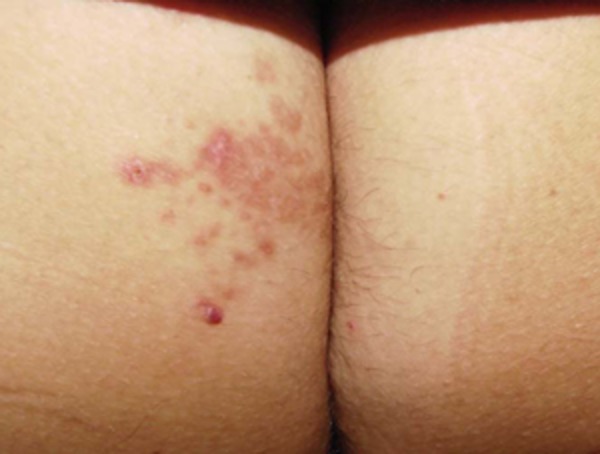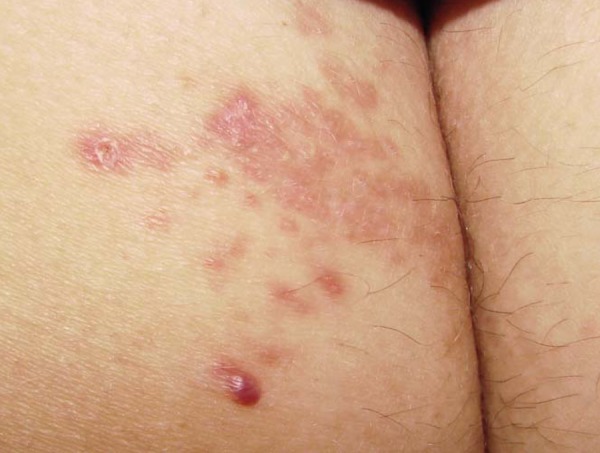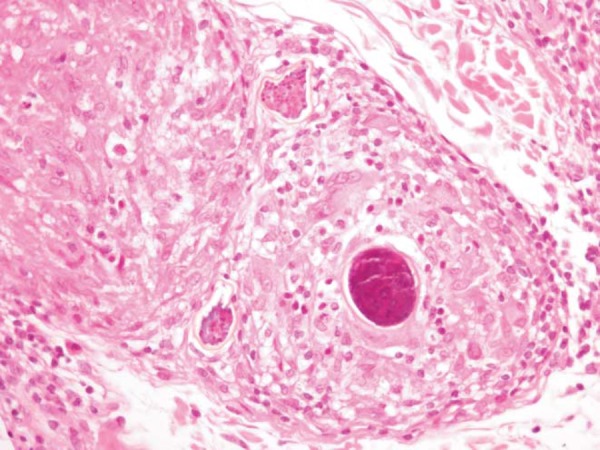Abstract
The authors report a case of ectopic cutaneous schistosomiasis in a 35 year-old female who presented clustered reddish macules and papules on the left buttock. The diagnosis was not suspected during clinical evaluation and required visualization of Schistosoma mansoni eggs on sections of tissue.
Keywords: Schistosoma mansoni, Schistosomiasis mansoni, Skin
Abstract
Os autores relatam um caso de esquistossomose cutânea ectópica em uma paciente de 35 anos que apresentou máculas e pápulas eritematosas agrupadas na nádega esquerda. O diagnostico não foi suspeitado durante a avaliação clínica, tendo sido obtido através da visualização dos ovos no exame histopatológico.
CASE REPORT
This was a thirty-five year-old, white, female patient born in Paraíba and resident in Jacarepaguá/RJ for the last 34 years. She presented with a cluster of reddish-coppery asymptomatic macules and papules on the left buttock, arising 30 days after a waterfall bathing at the countryside of the state (Figures 1 and 2). The diagnostic hypotheses were larva migrans, residual herpes simplex and sarcoidosis. Histopathological examination showed epithelioid granulomas surrounding eggs with an insinuation of a lateral spine, containing miracidia (Figure 3 and 4). Complete examination of gastrointestinal system and parasitological stool analysis did not show any alterations.
FIGURE 1.

Reddish-coppery cluster of macules and papules at the left buttock
FIGURE 2.

Reddish-coppery macules and papules, clustered and with a smooth surface. One of the lesions is eroded
FIGURE 3.

Medium dermis with an epithelioid granuloma surrounding three Schistosoma mansoni eggs. HE, 100X
FIGURE 4.

Detail of the three Schistosoma mansoni eggs containing viable miracidia. Notice that the in the eggs on the left side, it is possible to identify the characteristic lateral spine. HE, 400x
DISCUSSION
Ectopic cutaneous schistosomiasis happens when the trematodes' eggs are deposited in the dermis, instead of being eliminated via stools (S. japonicum and S. mansoni) or urine (S. hematobium).1,2 The only species reported in Brazil is S. mansoni, whose eggs are identified by the presence of a thick lateral spine.3 Lesions are typically located at the periumbilical region, torso, superior dorsal region, buttocks, and genital area. They appear as skin-colored papules, sometimes with a reddish-brown coloration, and may spontaneously regress or evolve to lichenified, vegetant or even tumoral lesions. Ulceration and fistulization may also occur.3,4,5
There were previous case reports of schistosomiasis in the region of Jacarepaguá. We believe the patient had already contracted the disease previously to this last waterfall bathing, because the acute phase usually presents with hepatoesplenomegalia and the period of egg laying starts 40 days after the infection.3,6,7 In the chronic phase of schistosomiasis, the process of egg laying is diminished, and it becomes difficult to detect them on stool samples. Only 2 to 7% of (chronic) patients develop portal hypertension in Brazil4,6,7
Footnotes
Conflict of interest: None
Financial funding: None
* Work performed at the Laboratory of Dermatology Investigation (ID)- Rio de Janeiro (RJ), Brazil.
REFERENCES
- 1.Andrade Filho Jde S, Lopes MS, Corgozinho Filho AA, Pena GP. Ectopic cutaneous schistosomiasis: report of two cases and a review of the literature. Rev Inst Med Trop São Paulo. 1998;40:253–257. doi: 10.1590/s0036-46651998000400009. [DOI] [PubMed] [Google Scholar]
- 2.Lopes R, Sousa MAJ, Jeunon T. Tropical troves: what is your diagnosis? [cited 2012 Sep 9];Dermatopathol Pract Conc. 2010 16:3. Available from: http://www.derm101.com. [Google Scholar]
- 3.Nunes FC, Costa MCE, Filhote MIF, Sharapinn Perfil Epidemiológico da esquistossomose mansônica no bairro Alto da Boa Vista, no Rio de Janeiro. Epidemiological profile o mansonic schistosomiasis at Alto da Boa Vista neighborhood in Rio de Janeiro. Cad Saúde Colet (Rio J) 2005;13:605–616. [Google Scholar]
- 4.Carmo EH, Bina JC, Barreto ML. Schistosomiasis related morbidity in Brazil; Spatial distribution, clinical features evolution and medical services assessment; Simpósio internacional sobre esquistossomose; Recife, PE. 1997; p. 166. [Google Scholar]
- 5.Costa IM, Moreira RR, Moraes MA. Esquistossomose mansônica cutânea ectópica. Ectopic cutaneous mansonic schistosomiasis. An Bras Dermatol. 1989;64:183–184. [Google Scholar]
- 6.Ferreira LF, Naveira JB, Silva JR. Fase toxêmica da esquistossomose mansoni. Toxemic phase of mansonic schistosomiasis. Rev Inst Med Trop Sao Paulo. 1960;2:112–120. [Google Scholar]
- 7.Domingues AL, Medeiros TB, Lopes EP. Ultrasound versus biological markers in the evaluation of periportal fibrosis in human Schistosoma mansoni. Mem Inst Oswaldo Cruz. 2011;106:802–807. doi: 10.1590/s0074-02762011000700004. [DOI] [PubMed] [Google Scholar]


